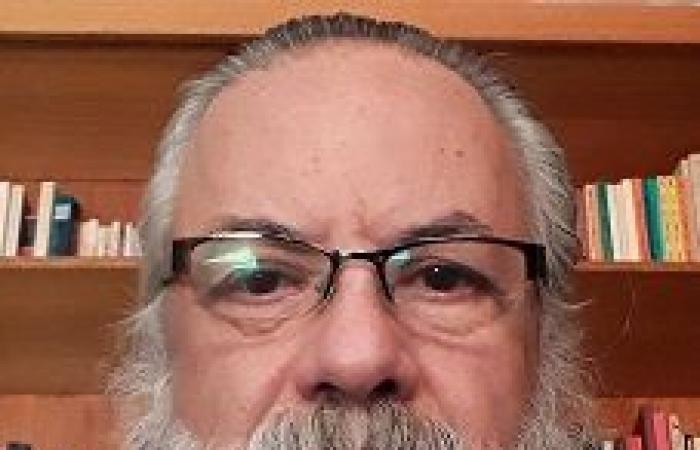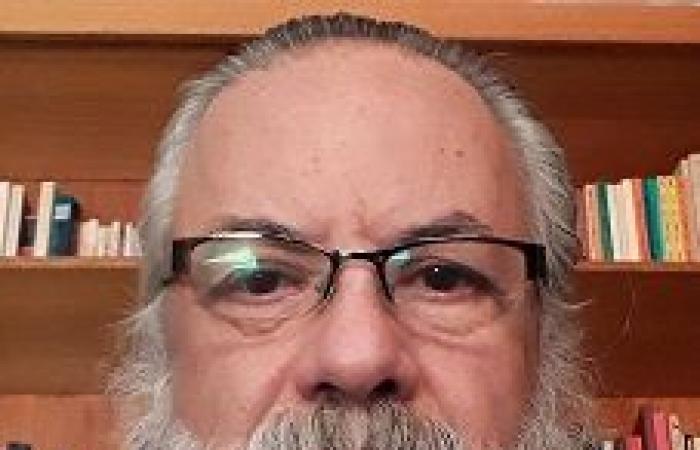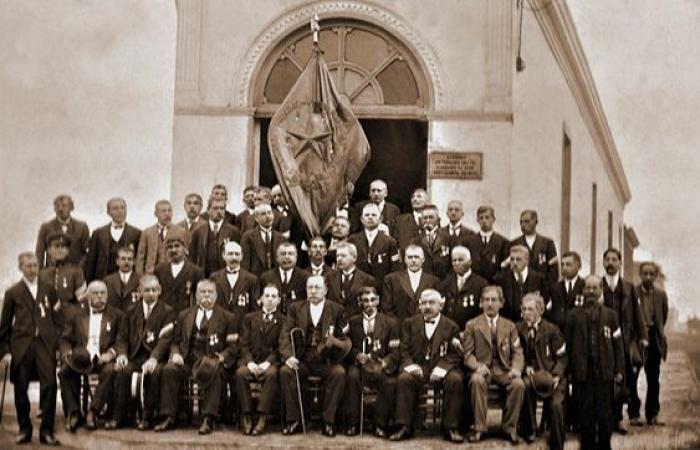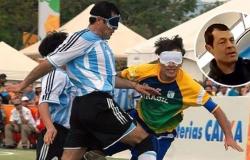Iván Vera-Pinto Soto, Social Scientist, Pedagogue and playwright.-
A brief count of heritage and cultural memory of the Veterans Chamber of 79.
After the Pacific war, a group of surviving Chilean soldiers founded the Mutualist Society, an entity that was officially recognized on September 2, 1900. Five years later, on May 21, 1905, they opened its headquarters in Vicente Zegers 150, at the Diamond tip of the historic El Morro neighborhood.
The land was assigned by the State through Decree No. 1,522, and the building was completed thanks to the collective effort of its partners, under the direction of the architect Luis Fernando Gassols, who also served as vice president of the organization.
In that headquarters, meetings, artistic evenings, talks, dances and encounters were held in which memories of war were shared. They also had a library, photographs and historical objects donated by the ex -combatants themselves.
Every May 21, the mutualists proudly paraded wearing their medals. Many lived in poverty, but were recognized as heroes by the community. From that contradiction the known saying is born: “The payment of Chile”.
during the weekends, the headquarters became an active cultural center. Poetry, music, theater and dance numbers were presented, accompanied by typical food and popular dances such as cuecas, waltzes and tangos. Neighbors of the sector still remember the intense billboard of the 40s, when theater companies and amateur artists filled the room.
The enclosure was also the scenario of farewells. One of the most remembered funerals was that of Mrs. Filomena Valenzuela Goyenechea, Cantinera of the Army and Battles heroine such as Pisagua and Dolores.
In December 1907, during the strike of the Salitre workers, the mutualists opened their doors to feed and house the workers who descended from the saltpeter offices. Many of them were former arms companions.
With the passage of time and the death of its founders, the headquarters continued as an art and memory space. In 1956 he welcomed the Iquique Polyphonic Choir, led by Master Dusan Teodorovic. Years later, his son Nesko founded the Cut Theater there.
In 1979, already under the administration of the university of Chile, the building was restored with the support of the Digider. That same year, on September 9, the Expression University Theater was created, which until today maintains an active billboard of works, workshops and events open to the community.
Currently, the Arturo Prat University – heir of the legacy of the University of Bello in the region – continues this work of protection and heritage projection, promoting the Iquiqueño art together with various groups and creators, with the aim of contributing to the cultural development of Iquique.
The ghosts of the past:
What has been exposed so far is what states in historical records; However, there is a little explored dimension, of which little is known or has preferred to remain silent throughout the 120 years of building existence. I speak of the energies that inhabit their walls, vestiges of the ancient inhabitants, artists and emblematic personalities who crossed their threshold. Friendly ghosts that seem to stay anchored over time, keeping secrets that only some dare to count.
Many of the actors, actresses and technicians of the Expression Theater, who have been working in this auditorium for 46 years, are witnesses of phenomena that occur periodically, becoming an integral part of our daily theatrical experience. Inexplicable facts that are intertwined with the routine, as if the place itself keep secrets in their shadows.
As an illustration, he tells some of the most shocking anecdotes we have lived. As an example, I remember that Saturday, January 9, 2005, when we watched in the room the remains of Guillermo “Willie” Zegarra, one of the iconic characters of the Iquiqueño theater. During the ceremony, the members of the District Tuna sang next to their coffin, when, suddenly, the lights went out for a moment. After a slight flickering, they assigned and lit again, as if it were a silent sign that his stamp was still there, among us.
The next day, after performing his funeral in cemetery No. 3, I returned to the enclosure to keep the belongings that had remained on stage. All the lights were off. Suddenly, while traveling the shrimp hall, the ampoules surrounding the mirrors of one of them lit up. The most disconcerting is that these luminaires only worked if they connected directly to the power outlet. How had it happened? I found no logical explanation. Something, or someone, was there … Don “Willie” was still present.
With the passage of time, in 2009, during a function of Ernesto Caballero’s “Muses” work, a disturbing event occurred. Giovanna Díaz, a young university actress, was in the dressing room preparing for a scene. While changing costumes, something made her look at the mirror. What saw her paralyzed: behind her, reflected in the glass, was the figure of Zegarra, motionless, watching her.
Terrified, the young woman leap back, her heart beating. About to break into the scene, his mind clouded by fear managed to stop thanks to the intervention of his teammates, who, from the scenes, seeing his panic, rushed to calm her. If it had not been for them, the function would have been interrupted in the midst of horror.

In another eventuality, I was teaching to the group of students. The whole team was on stage when a student was late to the session. He asked me for permission to join the activity, and when he went up to the entarimado, he looked at me confused and asked me:
“Professor, who is that gentleman who was just by her side?”
Intrigued, I replied:
“Who do you mean?”
“That lord of gray hair, thin and a lot of age …”
—Ah, es don “Willie”.
“Work here?” The student insisted.
“I worked … He died years ago,” I replied, with the feeling that, in some invisible corner, he was still present.
The truth is that the paranormal stories related to Guillermo Zegarra are repeated again and again, in various trances and in different corners of the room. Several actresses have experienced the rubbing of their hands on their arms, or even the feeling of a caress in their heads, as if he were, in some way, close, observing in silence from the dark.
But it is not the only appearance that has manifested in that space. One night in May 2013, while rehearsing the work “Delirio”, something strange happened. Suddenly, a water key in the sink of the interior bathrooms opened on its own. I went quickly to the place and discovered that the water flowed with an unusual force, the key completely open. I closed it and returned to the rehearsal.
Not even a few minutes had passed when Jeannette Baeza, costume designer and who directed my text from the stalls, asked me to go down immediately from the scene. I looked back and, in the gloom, I saw a great shadow that stalked me. Without thinking twice, we decided to leave the place. The same professional, in one morning while working in scenographic production, felt how some steps crossed the hall of the room. The footsteps resonated heavy, as if someone walks on the plate of the stalls, a sound that did not seem to have origin in the tangible world.
In several circumstances, all have experienced the strange feeling that someone, or something, walks from one side to another on stage. The footsteps creak clearly on the wooden floor, pausing at times before resuming their walk, as if an invisible appearance slide in a time that seems to have no end.
It is no chance that, sometimes, the illuminations of certain sectors do not work properly, or that from the lighting and sound booth, inexplicable murmurs are heard.
One of the most unusual episodes occurred during the assembly of “The King dies” by Eugenio Ionesco (1986), when several members of the company began to suffer serious diseases that put the premiere of the work at risk. Given the magnitude of the events, we had no choice but to resort to the intervention of a Yatiri, who made a ritual to “clean” the “evil spirits.” Only then, as if by magic, production could continue and get to fruition.
Some even claim to have felt the presence of the ex -combatants, as if their spirits still remain there, vigilant and attentive to what happens on stage.
Those who have worked in this historical room say that, as in other ancient theaters, only the energy of the artists who made history, but some claim to have seen spectral figures or have felt that someone observes them from the shadows. Sometimes, the strange phenomenon has been reported that objects on stage move for themselves, as if an invisible force manipulated them.
Over the years, rumors about the image of the ancient inhabitants of the theater, from actors and musicians to possible victims of past tragedies, have become part of the memory of the building. This room has witnessed passions, misfortunes and moments that seem not to have been forgotten by the souls that, according to some, continue to hover among the memories of the tables.
This place has become a true living museum, where memories of war, art and tragedy merge with the inexplicable, leaving an indelible mark on those who dare to enter their recesses. Among its walls, the past never fades completely, and the energies of those who lived there still seem to walk, intangible but palpable, over time. For that reason, at each premiere, in each new project, I am forced to invoke the theater guard spirits. I invoke them with respect and reverence, asking for their protection and support, to guide us towards success in our noble initiatives.
Each function, each representation, becomes a tribute to them: to all who inhabited this sacred territory, whose echoes we continue to claim with our creations. We know that, somehow, they continue among us, observing in silence. When paying tribute, we give them a reason to remain present in each act, in each sigh of the stage. Because, in the end, the theater is the art of ghosts: a place where the spirits of the past find their resonance, where spirits come to life and memory never dies.








